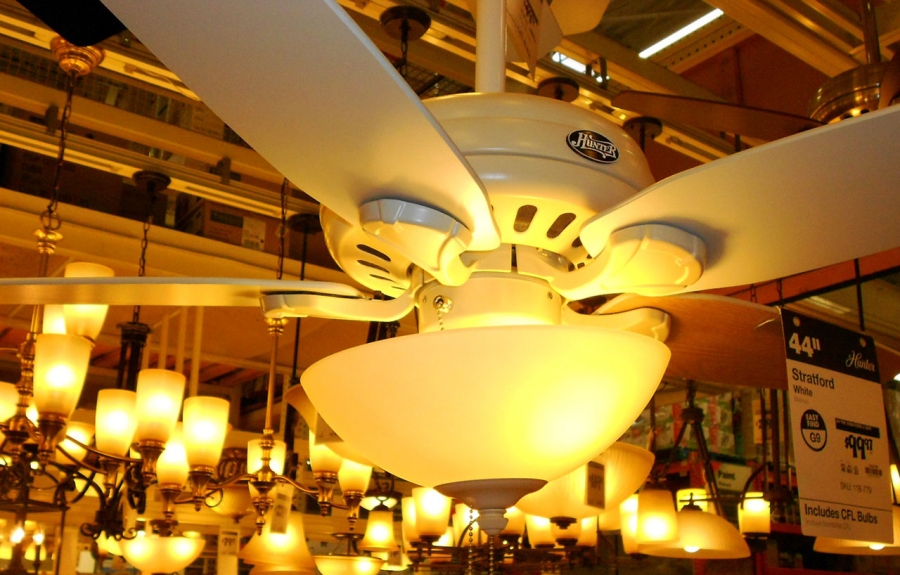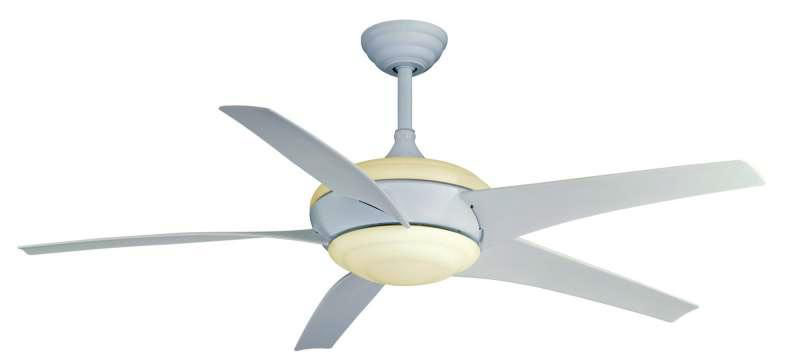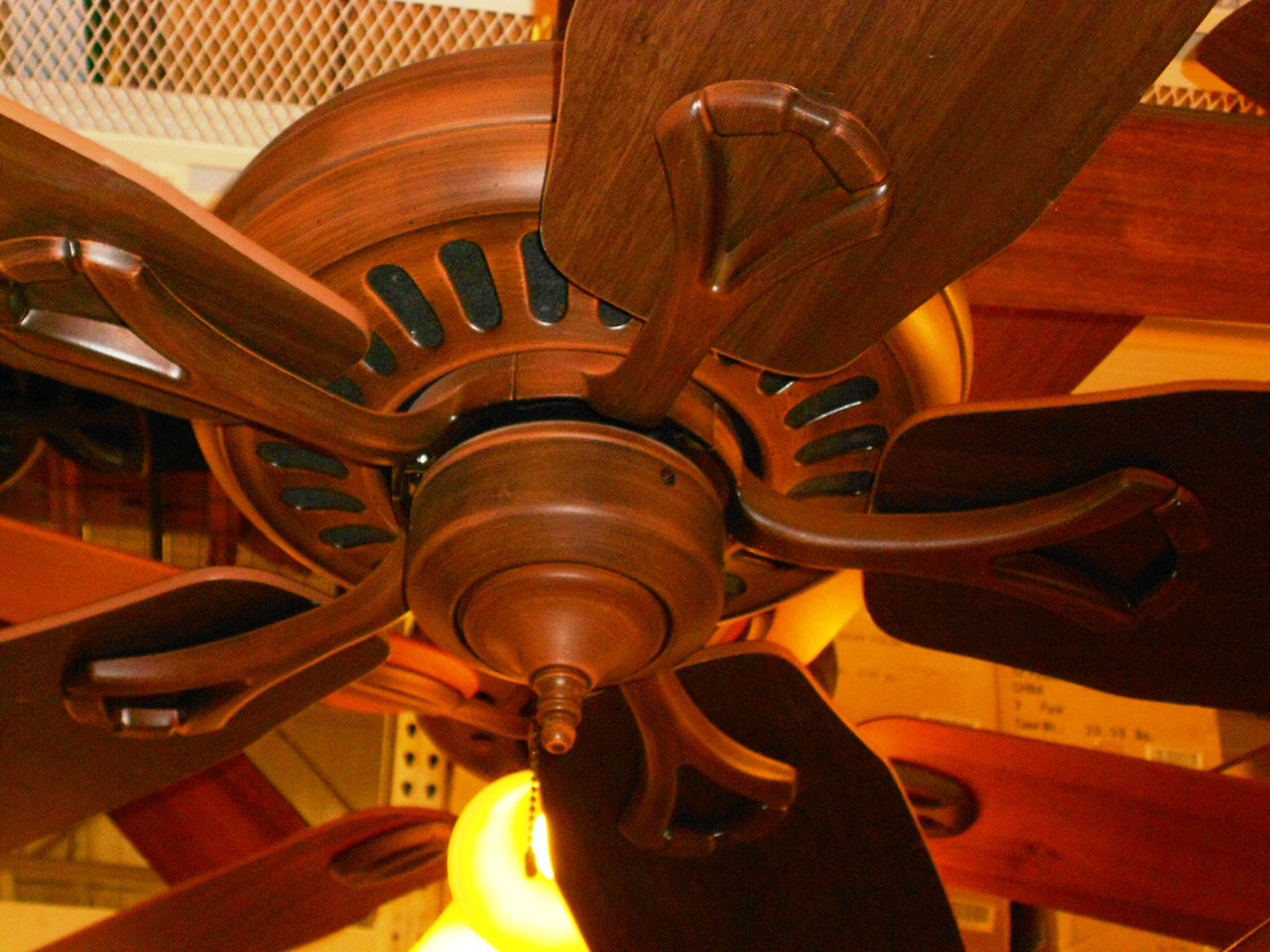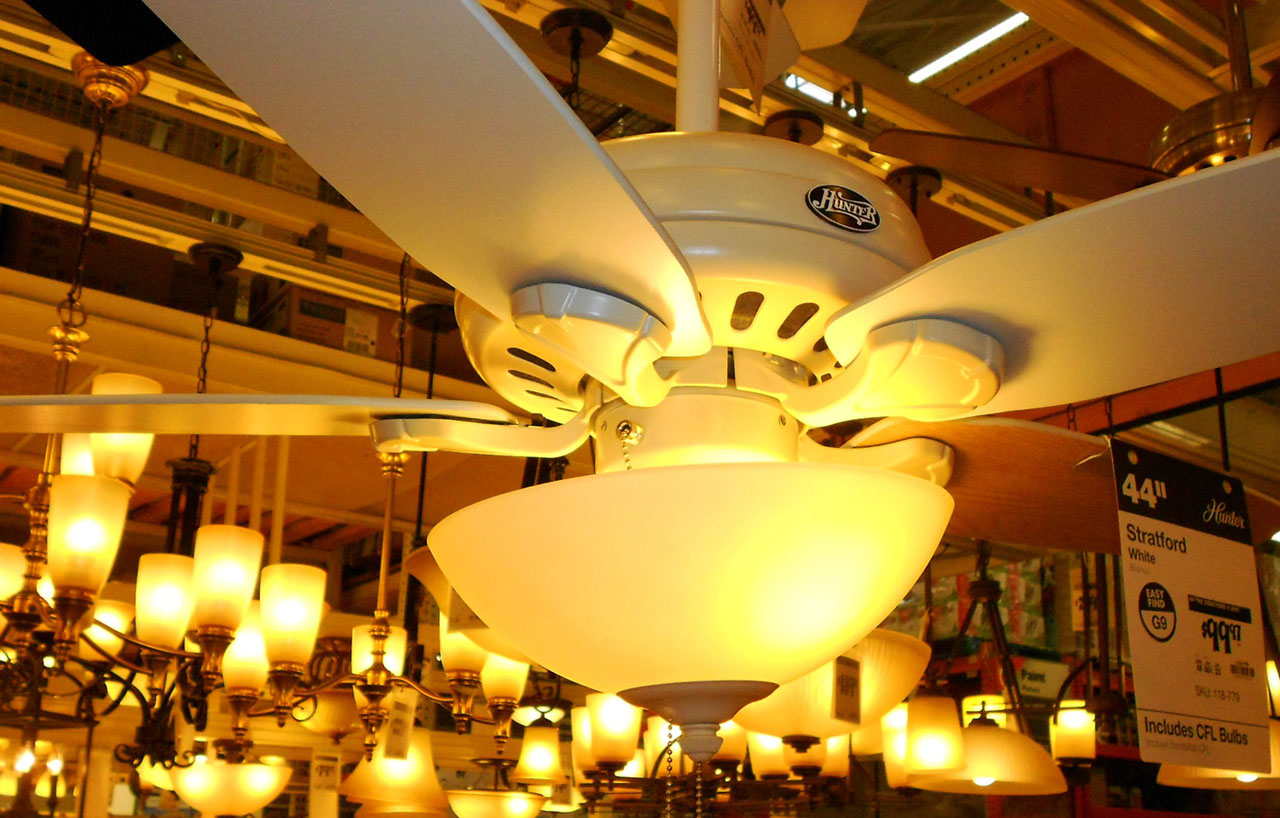Ceiling Fans: Part 1
Ceiling fans are an old-fashioned but effective and efficient approach to comfort.
Ever since one of our ancient ancestors picked up a palm leaf and used it to stir a cooling breeze, fans have played an important role in keeping us comfortable. From simple, hand-powered devices used to content Egyptian pharaohs, fans have evolved into automatic, efficient, climate-control appliances. Developed by father John and son James C. Hunter in 1886, the mechanical ceiling fan remains the most successful improvement. Even with the advanced climate control systems available today, ceiling fans provide an economical means of providing indoor comfort. As a supplement to central air conditioning, a ceiling fan can save 10% to 15% on summer cooling costs. In certain circumstances, a ceiling fan can help to balance home air temperatures for more efficient heating.
 Image courtesy of Fernando Pages Ruiz
Image courtesy of Fernando Pages Ruiz
Are you skeptical? Then consider the three simplest means of reducing energy consumption in a home: 1) Lowering thermostat settings in winter, 2) raising thermostat settings in summer, and 3) heating and cooling only those areas of home where people are present. By providing discrete, cooling breezes in summer and breaking up air stratification in winter, ceiling fans can assist in all three. To get the most out of your ceiling fan, you need a good one, sized for location, and you need to know how to use it.
Summer Savings

FANAWAY® is an advanced ceiling fan with unique aesthetics. Switched off, the traditionally intrusive fan blades automatically retract and conceal, and visually the unit transforms into a slim, modern light pendant. Turning the fan on creates a centrifugal force that deploys the blades to circulate air within a room. Photo courtesy of Fanaway International.
According to Energy Management Specialist Bob Ruskamp, of Lincoln Electric Systems, the windchill effect created by a ceiling fan can make a room feel about 4–6 degrees cooler, allowing you to raise your thermostat setting by a comparable amount. Raising your thermostat setting 1 degree Fahrenheit will lower your seasonal cooling bill by about 7%. Appliance industry sources site total energy savings of up to 40% during the cooling season, but Ruskamp prefers the more conservative estimate of 15%. “Industry figures reflect optimum conditions,” Ruskamp explains. “Most people don’t use their fans optimally or in ideal environments.”
Unlike air conditioning systems, fans don’t cool air. The air movement developed by a fan helps to evaporate moisture off the skin, dissipating body heat and making the room “feel” cooler. That’s why a ceiling fan won’t affect your thermostat reading. To achieve energy savings you have to raise the thermostat setting manually. Otherwise, a ceiling fan actually will boost your energy consumption. In one Florida study, researchers determined that adding ceiling fans without resetting thermostats raised energy use by an average of 10.5%. Proper use of fans, coupled with a 2 degree Fahrenheit increase in thermostat setting, resulted in average net energy savings of about 14.9%.
A ceiling fan can save energy in three ways:
-
By reducing air temperature sensation by 4 to 6 degrees Fahrenheit, you can turn up your thermostat, bypassing the air conditioning system entirely, until outside temperatures reach about 85 degrees Fahrenheit.
-
Higher indoor temperatures draw less outdoor heat through your walls, windows, and doors (heat itself does not rise – it moves from hot to cold). With less heat entering, your air conditioning system works less, reducing energy consumption and reducing stress on your equipment.
-
Depending on its speed setting, a typical fan consumes from 9 to 100 watts of energy, about the same energy as an average light bulb – considerably less than the 3,000 watts consumed by an average air conditioning system. Fans don’t release fluorocarbons. When you use a ceiling fan and raise your thermostat setting, you spare both money and the environment.
Winter Savings
The physics that buoys a hot air balloon works in your home, too: warm air rises (heat does not rise, but warm air does); dense, cool air falls. This causes “thermal stratification,” layers of hot and cold air. Temperatures in a room with a 12'-high ceiling can vary 15 degrees Fahrenheit from floor to ceiling. The air at your feet could be a chilly 65 degrees Fahrenheit, while the air trapped at ceiling level swelters at 80 degrees Fahrenheit. Add a ceiling fan, with the reverse switch set properly, and you can reduce this stratification to as little as 2 degrees Fahrenheit from floor to ceiling. Therefore your central heating system works less, saving fuel and money. Energy experts estimate an average savings between 1% to 2% for every degree you lower your thermostat setting. By breaking up the layers of air stratification in your home, you should be able to set your thermostat down to about 4 degrees Fahrenheit to 8 degrees Fahrenheit.
However, in homes with forced air heating and 8'-high ceilings, the cooling effect of a gentle “breeze,” even with a fan at low setting, will offset the benefits of mixing air. The winter application of ceiling fans works best in ceilings more than 12' in height or in homes with radiant heat.
For those using a radiant system, like passive solar heating or a wood stove, distributing heat evenly remains a vexing challenge. The common solution entails overheating one room while heating the rest of environment barely to comfort. A fan, slowly spinning clockwise, creates an upward draft, moving warm air across the ceiling and gently down the walls. This equalizes temperatures throughout the room.
Selecting a Fan
Most people select their ceiling fan by using aesthetic criteria, but those who want to use their fan as a component in their home’s cooling and heating must choose practically. A ceiling fan contains three major parts: motor, blades, and controls. Understanding each will help you to choose a fan that works best in your application.

Gossamer Windward III An aerodynamically designed ceiling fan developed by Danny Parker of the University of Central Florida Solar Energy Center (FSEC) with blades modeled after the propellers on the human-powered Gossamer Condor and Gossamer Albatross aircraft. Sold under the Hampton Bay label, the high-tech design was developed in concert with AeroVironment, Inc, a company specializing in advanced technology and aerodynamic design. The high-efficiency blades allow for the use of a smaller motor that the manufacturer claims to reduce typical fan energy consumption by 50%. Click on the hyperlink to see a Fan Development Project Report for this product. Photo courtesy of Gossamer Wind Series Ceiling Fans.
-
Motor. The best motors are like John Wayne: strong and silent. Look for a maintenance-free motor, with precision and lifetime bearings. The most efficient motors employ a “permanent-split capacitor” (PCS), which you will find in higher-quality fans only. These motors have the highest energy-efficiency ratings, run quietly, can be set to run in reverse, and don’t produce radio interference.
-
Blades. Typically, fans have three to five blades. Many people believe that fans with more blades move more air, but the number of blades does not affect performance, only aesthetics. The important elements in blade performance are pitch, length, and balance. Lower-quality fans spin short blades with a shallow pitch of about 10 degrees. These fans swirl quickly but move less air than a slower fan with blades pitched at the industry standard of 14 degrees. Blade lengths range from 30" to 60". Generally, the longer the blade, the more air a fan moves.
Blade length must correlate with room size. Hunter Fan Company, a leading manufacturer of ceiling fans, suggests using a 32" fan for rooms up to 64 square feet, a 42" fan for rooms up to 144 square feet, a 44" fan for rooms up to 225 square feet, and a 52" fan for rooms up to 400 square feet. Rooms larger than 400 square feet require more than one fan.
-
Controls. Fan controls can vary from a simple on/off switch to a complex wireless remote. Most fans have a three-speed control switch built into the housing. Many people, however, opt for a variable-speed, solid-state wall control. It’s important not to confuse these variable-speed fan controls with the dimmer switches you can buy at a hardware store. Most are built for incandescent lamps only and could damage your fan’s motor. Even the best variable-speed controls designed for fan use will cause your motor to hum (an annoying side-effect in certain applications). The electronic speed controls built into your fan are designed to control hum. A wireless remote control, similar to those found on most television sets, works with your fan’s built-in speed controls, giving you maximum flexibility, without hum.

While a desired finish may be your first criteria for selecting a fan, function should also be a factor. At a minimum, choose a high-quality fan with an efficient, silent, maintenance-free motor and laminated blades pitched at about 14 degrees. Choose solid-state electronic controls, offering at least three speeds and a reverse switch.

The Hunter Fan Company dates back to 1886, when John Hunter and son James C. Hunter created the first water-driven ceiling fan in upstate New York. The company continues to innovate with new, standardized technology such as Auto Balance®, which guarantees wobble-free operation, and Dust Armor™ nanotechnology blade coating, which the manufacturer says repels dust buildup. More on this and other elements of advancing fan technology in Ceiling Fans, Part 2.
Fan blades come in many styles, from acrylic to hardwood. While blade material does not affect performance, the quality of the blade will affect durability. High-quality, laminated blades will not warp. Before installing your fan blades, check for warp by sighting down the edge of the blade, as if aiming a rifle. Also, blades must be balanced or the fan will wobble. Most quality blades come as balanced sets from the factory. Don’t try to exchange blades between different fans. If your ceiling fan starts wobbling, you can purchase a balancing kit. Similar to the dynamic balance weights placed on automobile rims when purchasing a new tire, the balance kit works to distribute the weight of the blades evenly.
In summary, choose a high-quality fan with an efficient, silent, maintenance-free motor and laminated blades pitched at about 14 degrees and choose solid-state electronic controls, offering at least three speeds and a reverse switch.
The next installment in this two-part article on ceiling fans will delve into more technical aspects of ceiling fan selection, placement and installation tips, as well as a look at the most advanced, energy-saving models available today. For those of you wanting more information, you can read about how ceiling fans and lights kits are rated for energy conservation at the Building Technologies web site of the U.S. Department of Energy, or check out the Ceiling Fans for Consumers section at the EPA’s Energy Star web site.

Fernando Pages Ruiz
Homebuilder, developer and author Fernando Pagés Ruiz builds in the Midwest and Mountain States and consults internationally on how to build high-quality, affordable and energy-efficient homes. As a builder, his projects have numerous awards including the 2008 “Green Building Single Family House of the Year” and the 2007 “Workforce Housing Award” from the National Association of Home Builders. In 2006, the Department of Housing and Urban Development's PATH project chose him to build America's first PATH Concept Home, a home that is affordable to purchase and to maintain while meeting the criteria of LEED for Homes, ENERGY STAR, MASCO Environments for Living, and the NAHB's Green Building standards. A frequent contributor to Fine Homebuilding and EcoHome magazines, Pagés is also the author of two books published by the Taunton Press: Building an Affordable House: A high-value, low-cost approach to building (2005) and Affordable Remodel: How to get custom results on any budget (2007).
Contact Fernando on facebook or by way of his website buildingaffordable.com.

